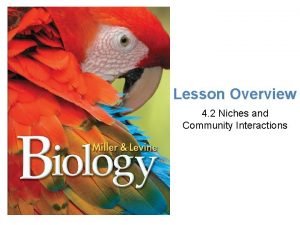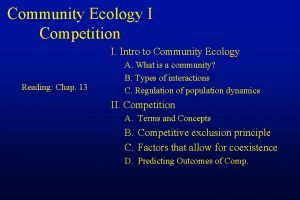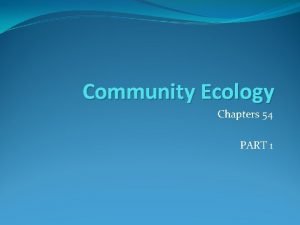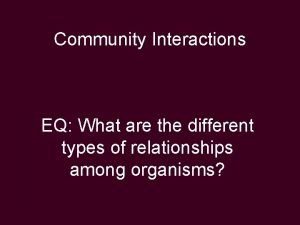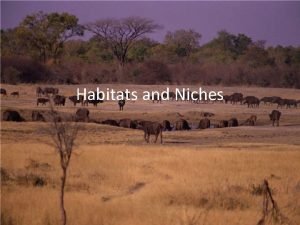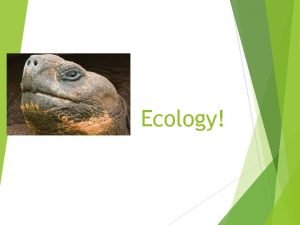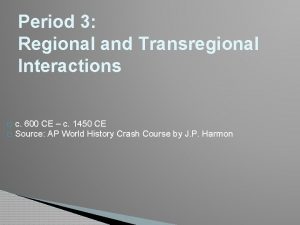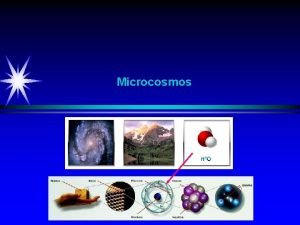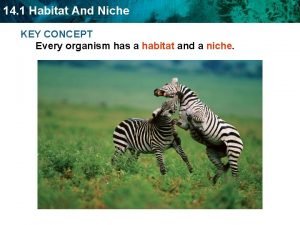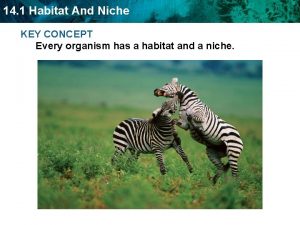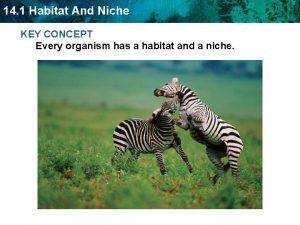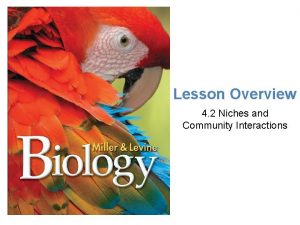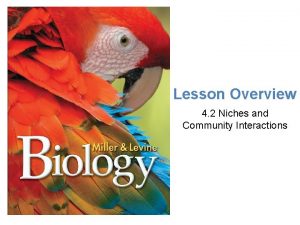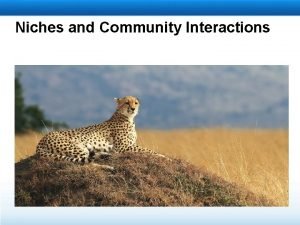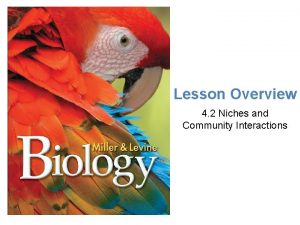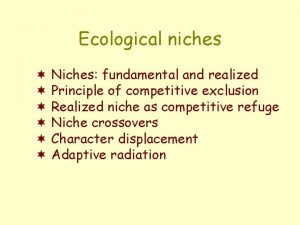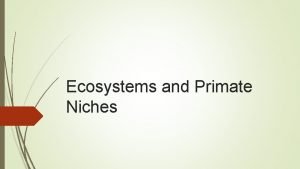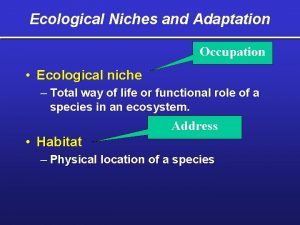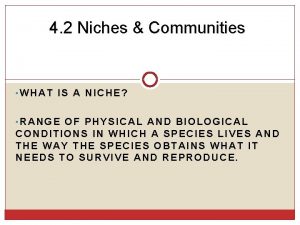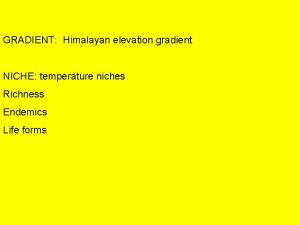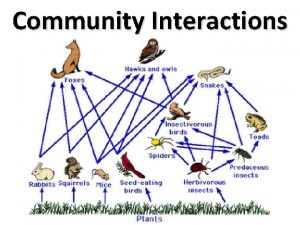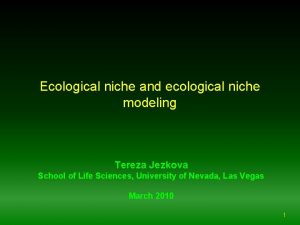Lesson Overview Niches and Community Interactions The Niche





































































- Slides: 69

Lesson Overview Niches and Community Interactions The Niche What is a niche? A niche is • the range of physical and biological conditions in which a species lives • the way the species obtains what it needs to survive and reproduce.

Lesson Overview Niches and Community Interactions Tolerance Every species has its own range of tolerance, the ability to survive and reproduce under a range of environmental circumstances.

Lesson Overview Niches and Community Interactions Tolerance When an environmental condition, such as temperature, extends in either direction beyond an organism’s optimum range, the organism experiences stress. The organism must expend more energy to maintain homeostasis, and so has less energy left for growth and reproduction.

Lesson Overview Niches and Community Interactions Tolerance Organisms have an upper and lower limit of tolerance for every environmental factor. Beyond those limits, the organism cannot survive. A species’ tolerance for environmental conditions, then, helps determine its habitat—the general place where an organism lives.

Lesson Overview Niches and Community Interactions Resources and the Niche Resource - any necessity of life, such as water, nutrients, light, food, or space. For plants, resources can include sunlight, water, and soil nutrients. For animals, resources can include nesting space, shelter, types of food, and places to feed.

Lesson Overview Niches and Community Interactions Physical Aspects of the Niche water, sunlight, temperature Biological Aspects of the Niche other organisms it eats, how it obtains food

Lesson Overview Niches and Community Interactions Competition How does competition shape communities? By causing species to divide resources, competition helps determine the number and kinds of species in a community and the niche each species occupies.

Lesson Overview Niches and Community Interactions Competition How one organism interacts with other organisms is an important part of defining its niche. Competition occurs when organisms attempt to use the same limited ecological resource in the same place at the same time.

Lesson Overview Niches and Community Interactions Competition In a forest, for example, plant roots compete for resources such as water and nutrients in the soil. Animals compete for resources such as food, mates, and places to live and raise their young. Competition can occur both between members of the same species (known as intraspecific competition) and between members of different species (known as interspecific competition).

Lesson Overview Niches and Community Interactions The Competitive Exclusion Principle Direct competition between different species almost always produces a winner and a loser —and the losing species dies out.

Lesson Overview Niches and Community Interactions The Competitive Exclusion Principle The competitive exclusion principle states that no two species can occupy exactly the same niche in exactly the same habitat at exactly the same time.

Lesson Overview Niches and Community Interactions The Competitive Exclusion Principle In the experiment shown in the graph, two species of paramecia (P. aurelia and P. caudatum) were first grown in separate cultures (dashed lines). In separate cultures, but under the same conditions, both populations grew. However, when both species were grown together in the same culture (solid line), one species outcompeted the other, and the less competitive species did not survive.

Lesson Overview Niches and Community Interactions Dividing Resources Instead of competing for similar resources, species usually divide them. For example, the three species of North American warblers shown all live in the same trees and feed on insects. But one species feeds on high branches; another feeds on low branches, and another feeds in the middle.

Lesson Overview Niches and Community Interactions Dividing Resources The resources utilized by these species are similar yet different. Therefore, each species has its own niche and competition is minimized. This division of resources was likely brought about by past competition among the birds. By causing species to divide resources, competition helps determine the number and kinds of species in a community and the niche each species occupies

Lesson Overview Niches and Community Interactions Predation, Herbivory, and Keystone Species How do predation and herbivory shape communities? Predators can affect the size of prey populations in a community and determine the places prey can live and feed. Herbivores can affect both the size and distribution of plant populations in a community and determine the places that certain plants can survive and grow.

Lesson Overview Niches and Community Interactions Predator-Prey Relationships An interaction in which one animal (the predator) captures and feeds on another animal (the prey) is called predation. Birds of prey, for example, can play an important role in regulating the population sizes of mice, voles, and other small mammals.

Lesson Overview Niches and Community Interactions Predator-Prey Relationships This graph shows an idealized computer model of changes in predator and prey populations over time.

Lesson Overview Niches and Community Interactions Herbivore-Plant Relationships An interaction in which one animal (the herbivore) feeds on producers (such as plants) is called herbivory. For example, very dense populations of white-tailed deer are eliminating their favorite food plants from many places across the United States.

Lesson Overview Niches and Community Interactions Keystone Species Sometimes changes in the population of a single species, often called a keystone species, can cause dramatic changes in the structure of a community. In the cold waters off the Pacific coast of North America, for example, sea otters devour large quantities of sea urchins. Urchins are herbivores whose favorite food is kelp, giant algae that grow in undersea “forests. ”

Lesson Overview Niches and Community Interactions Keystone Species A century ago, sea otters were nearly eliminated by hunting. Unexpectedly, the kelp forest nearly vanished. Without otters as predators, the sea urchin population skyrocketed, and armies of urchins devoured kelp down to bare rock. Without kelp to provide habitat, many other animals, including seabirds, disappeared. Otters were a keystone species in this community.

Lesson Overview Niches and Community Interactions Symbioses Any relationship in which two species live closely together is called symbiosis, which means “living together. ”

Lesson Overview Niches and Community Interactions Symbioses Biologists recognize three main classes of symbiotic relationships in nature: 1. Mutualism - both species benefit 2. Parasitism - one organism lives inside or on another organism and harms it. 3. Commensalism - one organism benefits and the other is neither helped nor harmed.

Lesson Overview Niches and Community Interactions Mutualism • The sea anemone’s sting has two functions: to capture prey and to protect the anemone from predators. Even so, certain fish manage to snack on anemone tentacles. • The clownfish, however, is immune to anemone stings. When threatened by a predator, clownfish seek shelter by snuggling deep into an anemone’s tentacles. • If an anemone-eating species tries to attack the anemone, the clownfish dart out and chase away the predators.

Lesson Overview Niches and Community Interactions Parasitism Tapeworms live in the intestines of mammals, where they absorb large amounts of their hosts’ food. Fleas, ticks, lice, and leeches live on the bodies of mammals and feed on their blood and skin. The parasite obtains all or part of its nutritional needs from the host organism. Generally, parasites weaken but do not kill their host, which is usually larger than the parasite

Lesson Overview Niches and Community Interactions Commensalism • Barnacles often attach themselves to a whale’s skin. • They perform no known service to the whale, nor do they harm it. • Yet the barnacles benefit from the constant movement of water—that is full of food particles—past the swimming whale.

Lesson Overview Succession Primary and Secondary Succession How do ecosystems change over time? Ecosystems change over time, especially after disturbances, as some species die out and new species move in.

Lesson Overview Succession Primary and Secondary Succession Ecological succession is a series of predictable changes that occur in a community over time. Over the course of succession, the number of different species present typically increases.

Lesson Overview Succession Primary Succession Volcanic explosions can create new land or sterilize existing areas. Retreating glaciers can have the same effect, leaving only exposed bare rock behind them. Succession that begins in an area with no remnants of an older community is called primary succession.

Lesson Overview Succession Primary Succession For example, in Glacier Bay, Alaska, a retreating glacier exposed barren rock. Over the course of more than 100 years, a series of changes has led to the hemlock and spruce forest currently found in the area.

Lesson Overview Succession Primary Succession The first species to colonize barren areas are called pioneer species. One ecological pioneer that grows on bare rock is lichen—a mutualistic symbiosis between a fungus and an alga.

Lesson Overview Succession Secondary Succession Sometimes, existing communities are not completely destroyed by disturbances. In these situations, secondary succession occurs. Secondary succession proceeds faster than primary succession, because soil survives the disturbance. As a result, new and surviving vegetation can regrow rapidly.

Lesson Overview Succession Secondary Succession Examples: • a wildfire • hurricane • logging • farming

Lesson Overview Succession Secondary Succession This series shows secondary succession taking place in abandoned fields of the Carolinas’ Piedmont. Over the last century, these fields have passed through several stages and matured into oak forests. Changes will continue for years to come.

Lesson Overview Succession Why Succession Occurs Every organism changes the environment it lives in. One model of succession suggests that as one species alters its environment, other species find it easier to compete for resources and survive. For example, as lichens add organic matter and form soil, mosses and other plants can colonize and grow. As organic matter continues to accumulate, other species move in and change the environment further. Over time, more and more species can find suitable niches and survive.

Lesson Overview Succession Climax Communities Do ecosystems return to “normal” following a disturbance? climax community – the “end” of succession. Secondary succession in healthy ecosystems following natural disturbances often reproduces the original climax community. Ecosystems may or may not recover from extensive human-caused disturbances.

Lesson Overview Succession Climax Communities Ecologists used to think that succession in a given area always proceeds through the same stages to produce a specific and stable climax community. Recent studies, however, have shown that succession doesn’t always follow the same path, and that climax communities are not always uniform and stable.

Lesson Overview Biomes Defining Biomes Ecologists classify Earth’s terrestrial ecosystems into at least ten different groups of regional climate communities called biomes. Biomes are described in terms of abiotic factors like climate and soil type, and biotic factors like plant and animal life. • • • Major biomes include: Rain forest Taiga Grassland Desert Temperate forest Tundra.

Lesson Overview Biomes Defining Biomes The map shows the locations of the major biomes.

Lesson Overview Biomes Defining Biomes Each biome is associated with seasonal patterns of temperature and precipitation that can be summarized in a graph called a climate diagram. A climate diagram shows the average temperature and precipitation at a given location during each month of the year. On this climate diagram, temperature is plotted as a red line, and precipitation is shown as vertical blue bars.

Lesson Overview Biomes Defining Biomes Organisms within each biome can be characterized by adaptations that enable them to live and reproduce successfully in the environment. However, even within a defined biome, there is often considerable variation among plant and animal communities. These variations can be caused by differences in exposure, elevation, or local soil conditions. Local conditions also can change over time because of human activity or because of community interactions.

Lesson Overview Biomes Vocabulary Terms Tall trees form a dense, leafy covering called a canopy from 50 to 80 meters above the forest floor. In the shade below the canopy, shorter trees and vines form a layer called the understory. A plant that sheds its leaves during a particular season is called deciduous. Coniferous trees, or conifers, produce seed-bearing cones, and most have needle-shaped leaves coated in a waxy substance that helps reduce water loss. The fertile soils are rich in humus, a material formed from decaying leaves and other organic matter. The tundra is characterized by permafrost, a layer of permanently frozen subsoil.

Lesson Overview Biomes Other Land Areas What areas are not easily classified into a major biome? Because they are not easily defined in terms of a typical community of plants and animals, mountain ranges and polar ice caps are not usually classified into biomes.

Lesson Overview Aquatic Ecosystems Conditions Underwater What factors affect life in aquatic ecosystems? Aquatic organisms are affected primarily by the water’s depth, temperature, flow, and amount of dissolved nutrients.

Lesson Overview Aquatic Ecosystems Water Depth Water depth strongly influences aquatic life because sunlight penetrates only a relatively short distance through water. The sunlit region near the surface in which photosynthesis can occur is known as the photic zone. The photic zone may be as deep as 200 meters in tropical seas, but just a few meters deep or less in rivers and swamps.

Lesson Overview Aquatic Ecosystems Water Depth Photosynthetic algae, called phytoplankton, live in the photic zone. Zooplankton—tiny free-floating animals—eat phytoplankton. This is the first step in many aquatic food webs. Below the photic zone is the dark aphotic zone, where photosynthesis cannot occur.

Lesson Overview Aquatic Ecosystems Water Depth Many aquatic organisms live on, or in, rocks and sediments on the bottoms of lakes, streams, and oceans. These organisms are called the benthos, and their habitat is the benthic zone. When the water is shallow enough for the benthic zone to be within the photic zone, algae and rooted aquatic plants can grow. When the benthic zone is below the photic zone, chemosynthetic autotrophs are the only primary producers.

Lesson Overview Aquatic Ecosystems Temperature and Currents Aquatic habitats are warmer near the equator and colder near the poles. Temperature in aquatic habitats also often varies with depth. The deepest parts of lakes and oceans are often colder than surface waters. Currents in lakes and oceans can dramatically affect water temperature because they can carry water that is significantly warmer or cooler than would be typical for any given latitude, depth, or distance from shore.

Lesson Overview Aquatic Ecosystems Freshwater Ecosystems What are the major categories of freshwater ecosystems? Freshwater ecosystems can be divided into three main categories: • rivers and streams • lakes and ponds • freshwater wetlands.

Lesson Overview Aquatic Ecosystems Rivers and Streams Rivers, streams, creeks, and brooks often originate from underground water sources in mountains or hills. Near a source, water has plenty of dissolved oxygen but little plant life.

Lesson Overview Aquatic Ecosystems Rivers and Streams Downstream, sediments build up and plants establish themselves. Farther downstream, water may meander slowly through flat areas. Animals in many rivers and streams depend on terrestrial plants and animals that live along their banks for food.

Lesson Overview Aquatic Ecosystems Freshwater Wetlands A wetland is an ecosystem in which water either covers the soil or is present at or near the surface for at least part of the year. Water may flow through freshwater wetlands or stay in place. Wetlands are often nutrient-rich, highly productive, and serve as breeding grounds for many organisms. Freshwater wetlands purify water by filtering pollutants and help to prevent flooding by absorbing large amounts of water and slowly releasing it.

Lesson Overview Aquatic Ecosystems Freshwater Wetlands Three main types of freshwater wetlands are: • freshwater bogs • freshwater marshes • freshwater swamps. Saltwater wetlands are called estuaries.

Lesson Overview Aquatic Ecosystems Estuaries An estuary is a special kind of wetland, formed where a river meets the sea. Estuaries contain a mixture of fresh water and salt water, and are affected by the rise and fall of ocean tides. Many are shallow, which means that enough sunlight reaches the benthos to power photosynthesis. Estuaries serve as spawning and nursery grounds for many ecologically and commercially important fish and shellfish species including bluefish, striped bass, shrimp, and crabs.

Lesson Overview Aquatic Ecosystems Marine Ecosystems How do ecologists usually classify marine ecosystems? Ecologists typically divide the ocean into zones based on depth and distance from shore. Starting with the shallowest and closest to land, marine ecosystems include: • the intertidal zone • the coastal ocean • the open ocean.

Lesson Overview Aquatic Ecosystems Marine Ecosystems This diagram shows the different zones in an ocean.

Lesson Overview Aquatic Ecosystems Intertidal Zone Organisms in the intertidal zone are submerged in seawater at high tide and exposed to air and sunlight at low tide. These organisms are subjected to regular and extreme changes in temperature and are often battered by waves and currents.

Lesson Overview Aquatic Ecosystems Intertidal Zone A typical rocky intertidal community exists in temperate regions where exposed rocks line the shore. There, barnacles and seaweed permanently attach themselves to the rocks.

Lesson Overview Aquatic Ecosystems Coastal Ocean The coastal ocean extends from the low-tide mark to the outer edge of the continental shelf—the relatively shallow border that surrounds the continents.

Lesson Overview Aquatic Ecosystems Coastal Ocean Water in the coastal ocean is brightly lit, and is often supplied with nutrients by freshwater runoff from land. As a result, coastal oceans tend to be highly productive. Kelp forests and coral reefs are two important coastal communities.

Lesson Overview Aquatic Ecosystems Open Ocean The open ocean begins at the edge of the continental shelf and extends outward.

Lesson Overview Aquatic Ecosystems Open Ocean More than 90 percent of the world’s ocean area is considered open ocean.

Lesson Overview Aquatic Ecosystems Open Ocean The open ocean is divided into two zones based on light penetration— the photic and aphotic.

Lesson Overview Aquatic Ecosystems The Open Ocean Photic Zone The open ocean typically has low nutrient levels and supports only the smallest species of phytoplankton. Still, because of its enormous area, most photosynthesis on Earth occurs in the sunlit top 100 meters of the open ocean.

Lesson Overview Aquatic Ecosystems The Open Ocean Aphotic Zone The permanently dark aphotic zone includes the deepest parts of the ocean.

Lesson Overview Aquatic Ecosystems The Open Ocean Aphotic Zone Food webs in the aphotic zone are based either on organisms that fall from the photic zone above, or on chemosynthetic organisms. Deep ocean organisms, like hatchet fish, are exposed to high pressure, frigid temperatures, and total darkness. Benthic environments in the deep sea were once thought to be nearly devoid of life but are now known to have islands of high productivity. Deep-sea vents, where superheated water boils out of cracks on the ocean floor, support chemosynthetic primary producers.

Lesson Overview Aquatic Ecosystems

Lesson Overview Aquatic Ecosystems

Lesson Overview Aquatic Ecosystems

Lesson Overview Aquatic Ecosystems
 6.1 habitats niches and species interactions answer key
6.1 habitats niches and species interactions answer key Niches and community interactions
Niches and community interactions Can a realized niche be larger than a fundamental niche
Can a realized niche be larger than a fundamental niche Example of apparent competition
Example of apparent competition Parasitism
Parasitism Examples of biotic components
Examples of biotic components Niche tourism examples
Niche tourism examples Les fossettes palatines
Les fossettes palatines La ligne faitiere des cretes
La ligne faitiere des cretes Interactions between ais and internal and external parties
Interactions between ais and internal and external parties Chapter 9 lesson 2 photosynthesis an overview
Chapter 9 lesson 2 photosynthesis an overview Lesson overview
Lesson overview Qualitative quantitative
Qualitative quantitative Macroeconomics lesson 2 activity 45
Macroeconomics lesson 2 activity 45 Properties and interactions of magnets
Properties and interactions of magnets Sphere interactions
Sphere interactions Product architecture design
Product architecture design Factors affecting communication skills
Factors affecting communication skills Symbiosis and species interactions keystone webquest
Symbiosis and species interactions keystone webquest Naive bayes pays attention to complex interactions and
Naive bayes pays attention to complex interactions and Define product architecture
Define product architecture Regional and transregional interactions
Regional and transregional interactions Microcosmos macrocosmos
Microcosmos macrocosmos Regional and transregional interactions
Regional and transregional interactions Hourglass contracture of stomach
Hourglass contracture of stomach Realized niche
Realized niche Habitat and niche
Habitat and niche The lion’s ecological niche includes its behavior and
The lion’s ecological niche includes its behavior and Ulcer niche and ulcer notch
Ulcer niche and ulcer notch Whats the difference between a niche and a habitat
Whats the difference between a niche and a habitat Advantages of mass marketing
Advantages of mass marketing Natural selection requirements
Natural selection requirements Hát kết hợp bộ gõ cơ thể
Hát kết hợp bộ gõ cơ thể Ng-html
Ng-html Bổ thể
Bổ thể Tỉ lệ cơ thể trẻ em
Tỉ lệ cơ thể trẻ em Voi kéo gỗ như thế nào
Voi kéo gỗ như thế nào Chụp phim tư thế worms-breton
Chụp phim tư thế worms-breton Hát lên người ơi alleluia
Hát lên người ơi alleluia Các môn thể thao bắt đầu bằng tiếng nhảy
Các môn thể thao bắt đầu bằng tiếng nhảy Thế nào là hệ số cao nhất
Thế nào là hệ số cao nhất Các châu lục và đại dương trên thế giới
Các châu lục và đại dương trên thế giới Cong thức tính động năng
Cong thức tính động năng Trời xanh đây là của chúng ta thể thơ
Trời xanh đây là của chúng ta thể thơ Mật thư anh em như thể tay chân
Mật thư anh em như thể tay chân Phép trừ bù
Phép trừ bù độ dài liên kết
độ dài liên kết Các châu lục và đại dương trên thế giới
Các châu lục và đại dương trên thế giới Thơ thất ngôn tứ tuyệt đường luật
Thơ thất ngôn tứ tuyệt đường luật Quá trình desamine hóa có thể tạo ra
Quá trình desamine hóa có thể tạo ra Một số thể thơ truyền thống
Một số thể thơ truyền thống Cái miệng xinh xinh thế chỉ nói điều hay thôi
Cái miệng xinh xinh thế chỉ nói điều hay thôi Vẽ hình chiếu vuông góc của vật thể sau
Vẽ hình chiếu vuông góc của vật thể sau Nguyên nhân của sự mỏi cơ sinh 8
Nguyên nhân của sự mỏi cơ sinh 8 đặc điểm cơ thể của người tối cổ
đặc điểm cơ thể của người tối cổ V cc
V cc Vẽ hình chiếu đứng bằng cạnh của vật thể
Vẽ hình chiếu đứng bằng cạnh của vật thể Vẽ hình chiếu vuông góc của vật thể sau
Vẽ hình chiếu vuông góc của vật thể sau Thẻ vin
Thẻ vin đại từ thay thế
đại từ thay thế điện thế nghỉ
điện thế nghỉ Tư thế ngồi viết
Tư thế ngồi viết Diễn thế sinh thái là
Diễn thế sinh thái là Các loại đột biến cấu trúc nhiễm sắc thể
Các loại đột biến cấu trúc nhiễm sắc thể Thế nào là số nguyên tố
Thế nào là số nguyên tố Tư thế ngồi viết
Tư thế ngồi viết Lời thề hippocrates
Lời thề hippocrates Thiếu nhi thế giới liên hoan
Thiếu nhi thế giới liên hoan ưu thế lai là gì
ưu thế lai là gì Hươu thường đẻ mỗi lứa mấy con
Hươu thường đẻ mỗi lứa mấy con

